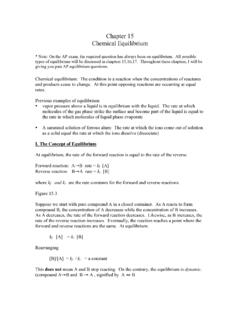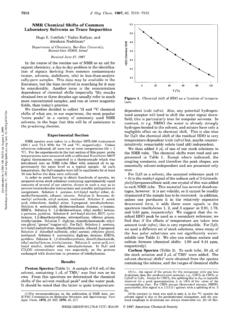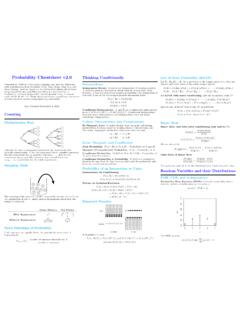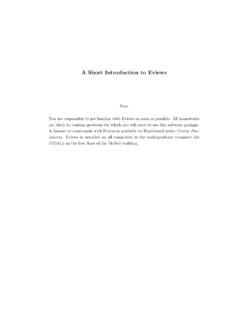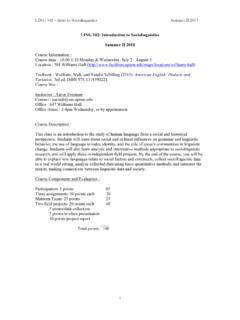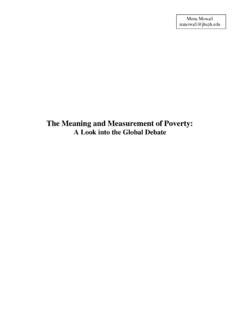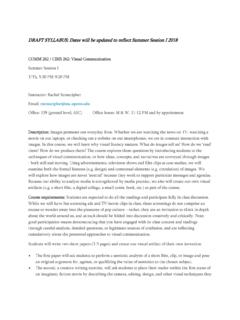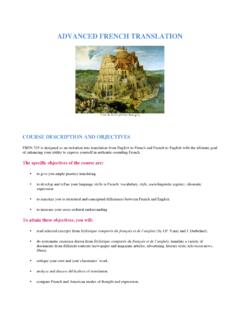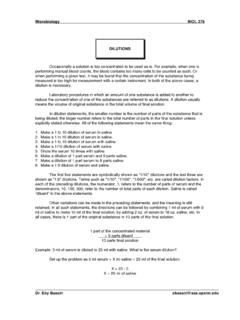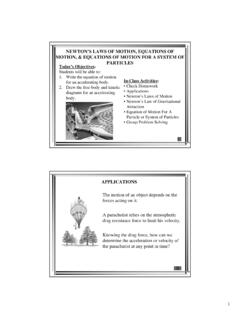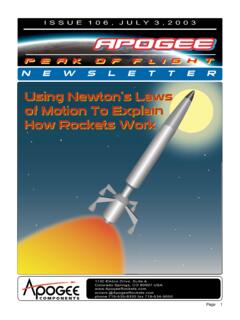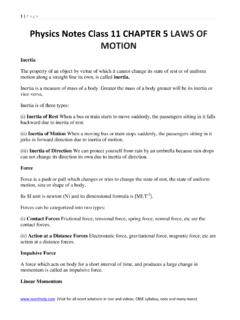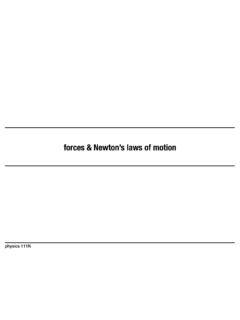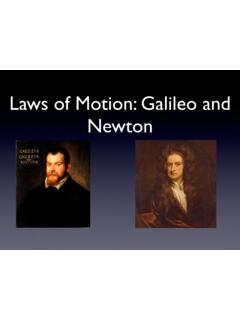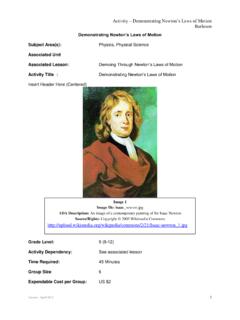Transcription of NEWTON’S LAWS OF MOTION
1 Name_____ Period_____ Date_____. NEWTON'S laws OF MOTION . If I am anything, which I highly doubt, I have made myself so by hard work. Isaac Newton Goals: 1. Students will use conceptual and mathematical models to predict and understand patterns in MOTION . ( ). 2. Students will be able to apply Newton's laws of MOTION to solve problems related to forces and mass. ( , ). 3. Students will integrate new information into existing theories and explain implied results. ( ). Information A Force is defined most simply as any push or pull. Newton's Three Law's of MOTION Newton's Newton's First Law Third Law Newton's Second Law Know as the Know as Law of Inertia Action-Reaction Expressed as F = ma Moving objects Objects at rest stay at If an object The 2nd exerts an keep moving rest exerts a force on equal & opposite another object force on the 1st More force means More mass means more acceleration less acceleration Unless acted on by an unbalanced force.
2 Critical Thinking Questions Part I. 1. Which law is associated with inertia? 2. If you increase the force on an object what happens to the acceleration? 3. If you use the same force on a less massive object what happens to the acceleration? 4. Which law states force is dependent on the mass and acceleration of an object? 5. What causes an object to slowdown or speed-up? 6. What law is known as the law of action-reaction? 7. Which law explains why when you bump into something you fall backwards? 8. If you double the force of an object what happens to the acceleration? 9. If you double the mass of an object what happens to the acceleration? 10. Force is measured in newtons (N). A newton is based on base units in the metric system. What is a newton equal to in terms of units of mass and acceleration? Exercises 1. When Jane drives to work, she always places her purse on the passenger's seat.
3 By the time she gets to work, her purse has fallen on the floor in front of the passenger seat. One day, she asks you to explain why this happens in terms of physics. What do you say? 2. You are waiting in line to use the diving board at your local pool. While watching people dive into the pool from the board, you realize that using a diving board to spring into the air before a dive is a good example of Newton's third law of MOTION . Explain how a diving board illustrates Newton's third law of MOTION . 3. You know the mass of an object and the force applied to the object to make it move. Which of Newton's laws of MOTION will help you calculate the acceleration of the object? 4. How many newtons of force are represented by the following amount: 3 kg m/sec2? Justify your answer. 5. Your shopping cart has a mass of 65 kilograms. In order to accelerate the shopping cart down an aisle at m/sec2, what force would you need to use or apply to the cart?
4 6. A small child has a wagon with a mass of 10 kilograms. The child pulls on the wagon with a force of 2 newtons. What is the acceleration of the wagon? 7. You dribble a basketball while walking on a basketball court. List and describe at least 3 pairs of action-reaction forces in this situation. Information Newton's First Law Forces are Balanced Newton's first law of MOTION is often stated as an object at rest tends to stay at rest and an object in Objects at Rest Objects in MOTION MOTION tends to stay in MOTION with the same speed V = 0m/s V 0m/s and in the same direction unless acted upon by an unbalanced force. In fact, it is the natural tendency of objects to resist a = 0 m/s2 a = 0 m/s2. changes in their state of MOTION . This tendency is described as inertia. A more massive object has a greater tendency to resist Stays at Rest Stays in MOTION V = 0m/s Same Velocity changes in its state of MOTION .
5 Inertia: the resistance an object has to a change in its state of MOTION . Forces are said to be balanced when the net force on the object are zero. That is when all the forces are added up the result is zero. For example when you are standing the force of gravity is balanced by the force of the floor holding you up. Forces are unbalanced when the net force is not zero. In a tug-of-war both teams apply forces. For a team to win the forces must be unequal or unbalanced. You want the net force to be in your direction. Critical Thinking Questions Part II. 1. Restate Newton's first law in terms of acceleration. 2. If the forces are balanced what is the resulting acceleration? 3. An object's resistance to change in MOTION is dependent solely on what quantity? 4. Inertia is the resistance to change in MOTION so inertia depends solely on what? 5. What is required to cause acceleration?
6 6. What is the net force if you push a cart to the right with 5N of force and a friend pushes the cart to the left with 5N of force? 7. What is the net force if you start to pull instead of pushing in #6? Exercises 1. Imagine a place in the cosmos far from all gravitational and frictional influences. Suppose that you visit that place (just suppose) and throw a rock. What will the rock do? Why? 2. Supposing you were in space in a weightless environment, would it require a force to set an object in MOTION ? Explain. 3. Why doesn't a ball roll on forever after being kicked at a soccer game? 4. A 2-kg object is moving horizontally with a speed of 4 m/s. How much net force is required to keep the object moving at this speed and in this direction? Explain. 5. Ben Tooclose is being chased through the woods by a bull moose which he was attempting to photograph.
7 The enormous mass of the bull moose is extremely intimidating. Yet, if Ben makes a zigzag pattern through the woods, he will be able to use the large mass of the moose to his own advantage. Explain this in terms of inertia and Newton's first law of MOTION . 6. Luke Autbeloe drops an approximately kg object (weight = N) off the roof of his house into the swimming pool below. Upon encountering the pool, the object encounters a N upward resistance force (assumed to be constant). Use this description to answer the following questions. (Down is usually considered a negative direction). a. Which one of the velocity-time graphs best describes the MOTION of the object? Why? b. True or False: Once the object hits the water, the forces are balanced and the object will stop. Support your answer with reasoning. Information Newton's Second Law As stated in the first law, the presence of an unbalanced Forces are Unbalanced force will accelerate an object - changing either its speed, its direction, or both its speed and direction.
8 Newton's second law of MOTION pertains to the behavior a 0. of objects for which all existing forces are not balanced. The second law states that the acceleration of an object is dependent upon two variables - the net force acting upon Depends directly Depends inversely the object and the mass of the object. The acceleration is on the net force on object's mass always in the same direction as the net force. Mathematically this means: Forcenet Fnet acceleration = ; a=. mass m commonly written as: Fnet = ma Do not use the value of merely any force in the above equation. It is the net force which is related to acceleration. The net force is the sum of all the forces acting on an object. Critical Thinking Questions Part III. 1. What two variables is acceleration dependent on? What is the relationship between these variables and acceleration? ( if you increase one variable what happens to the acceleration?)
9 2. If an object is not accelerating what can you determine about the sum of all the forces on the object? 3. If the net force on an object is in a negative direction, what will the direction of the resulting acceleration be? 4. If you double the net force on an object what is the result on the acceleration? 5. If you double the mass of an object while leaving the net force unchanged what is the result on the acceleration? 6. A Cadillac Escalade has a mass of 2 kg, if it accelerates at what is the net force on the car? 7. A bowling ball (16 pounds) is at rest at the end of a bowling lane. Use this information to answer the following questions. a. What is the net force acting on the ball? b. You push the ball with a force of which induces a frictional force. What is the net force while you push the ball? c. What is the acceleration caused by your push on the ball?
10 D. Following your push the ball rolls down the lane at What is the net force on the ball as it rolls down the lane at the constant speed? e. CHALLENGE: How long did you push the ball in this situation? Exercises 8. Complete the following table. Be sure to include units in your answer. Net Force (N) Mass (kg) Acceleration 12. 180 9. Complete the following table. Be sure to include units. Net Force (N) Mass (kg) Acceleration (m/s2). 53 3. 1 225 10. What is the rate of acceleration of a 2,000-kilogram truck if a force of 4,200 N is used to make it start moving forward? 11. What is the acceleration of a kilogram ball that is hit with a force of 25 N? 12. How much force is needed to accelerate a 68 kilogram-skier at a rate of m/sec2? 13. What is the mass of an object that requires a force of 30 N to accelerate at a rate of 5 m/sec2? 14. What is the force on a 1 000 kilogram-elevator that is falling freely under the acceleration of gravity only ( )?
